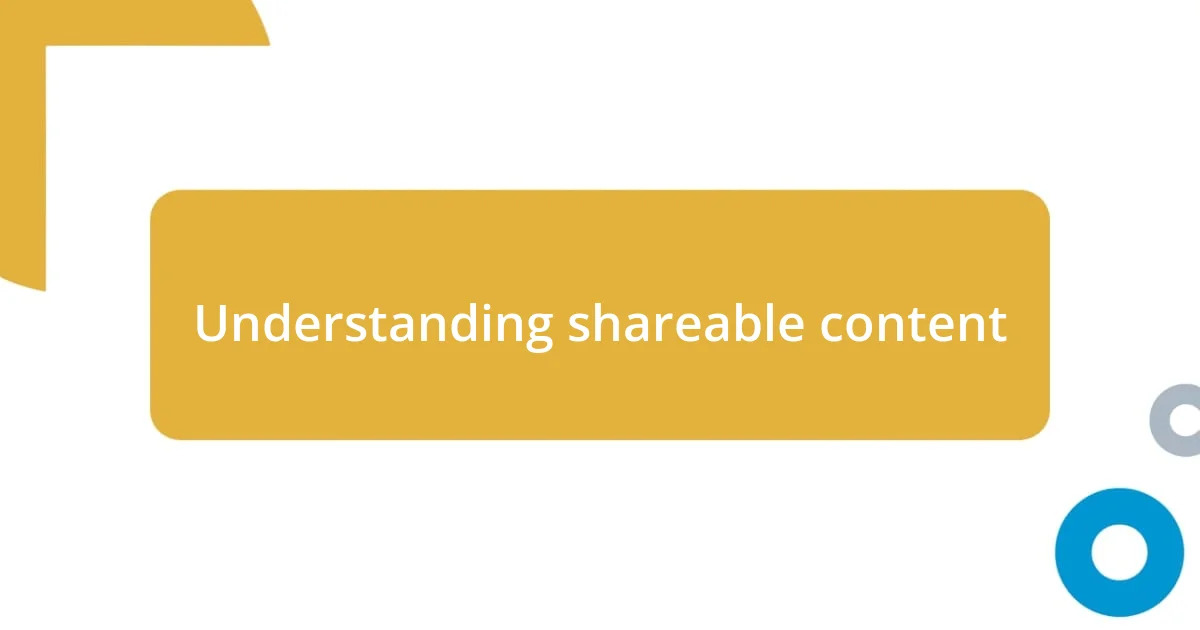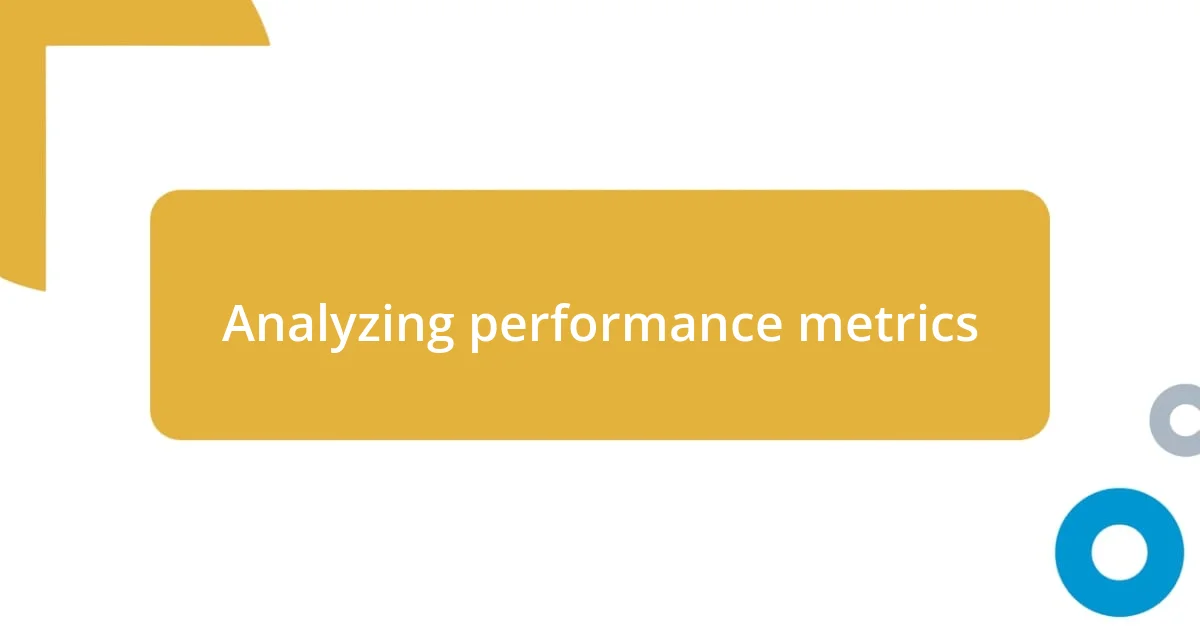Key takeaways:
- Shareable content resonates on an emotional level, combining relatability, visual appeal, and valuable insights to foster community and encourage sharing.
- Identifying and understanding your target audience is crucial for creating relevant content that addresses their demographics, interests, and pain points.
- Regularly analyze performance metrics and adjust strategies based on audience feedback to continually improve content engagement and sharing rates.

Understanding shareable content
Shareable content is all about resonating with your audience on a deeper level. When I reflect on posts that went viral, I often find myself considering why they struck such a chord. Was it humor, a compelling story, or a relatable struggle? Each piece of shareable content taps into universal emotions or experiences, compelling readers to share them with others who feel the same.
Think about the last time you shared something online. What made you hit that button? For me, it was a heartwarming story about kindness that reminded me of a moment in my own life when someone unexpectedly lifted my spirits. This emotional connection fosters a sense of community among readers and encourages the sharing of content that mirrors their personal experiences.
Ultimately, shareable content must also be visually appealing and easy to digest. I remember scrolling through a beautifully illustrated infographic that simplified complex information. It was engaging and instantly shareable. Have you ever encountered content that was so well-designed you felt compelled to share it just for its aesthetics? That’s the power of combining visual appeal with valuable insights.

Identifying your target audience
Identifying your target audience is essential for creating content that truly resonates. I remember when I first launched my blog without a clear sense of who I was writing for. My posts felt scattered, and engagement didn’t gain traction. It wasn’t until I took the time to understand my readers’ demographics, interests, and pain points that my content began to flourish. Knowing your audience allows you to tailor your message and speak directly to their needs.
To help identify your target audience, consider these key points:
- Demographics: Age, gender, location, and occupation can shape how people respond to content.
- Interests: What hobbies or topics excite your audience? Diving into these areas can spark ideas that resonate.
- Pain points: Understanding the challenges your audience faces helps create content that offers solutions.
- Engagement: Pay attention to which posts get the most interaction. These insights can guide your content strategy.
By honing in on who your audience is, you foster a connection that encourages sharing, making your content more relatable and impactful.

Crafting engaging headlines
Crafting engaging headlines is crucial for grabbing attention in a crowded digital space. I still remember the first time I wrote a headline that significantly increased my content’s visibility. It contained a question that piqued curiosity—“Have You Tried This Simple Trick to Boost Your Productivity?” I noticed engagement skyrocketed. Questions in headlines can be so powerful because they invite the reader to find out more and share their thoughts.
The choice of words in your headline can evoke emotions and set the tone for your content. I’ve often found that using strong adjectives or numbers can make a headline pop. For instance, instead of saying “Tips for Better Writing,” saying “5 Unbelievably Easy Tips for Transforming Your Writing Today” feels much more compelling. The numerical aspect draws readers in, and strong adjectives stir up excitement or intrigue.
Lastly, I believe experimenting with different headline styles is essential. Sometimes I jot down ten variations for the same post and review which resonates more with my audience. Using tools like A/B testing can also provide insights into what headlines perform best. This trial and error process often leads to that “aha” moment where the perfect headline emerges, catching attention and encouraging sharing.
| Headline Style | Example |
|---|---|
| Question | “Are You Making These Common Mistakes in Your Writing?” |
| Numbered List | “10 Essential Tips for Crafting Engaging Headlines” |
| Intriguing Statement | “The Secret to Viral Content Lies in This One Simple Change” |
| Adjectives | “Remarkably Effective Strategies for Captivating Your Audience” |

Utilizing compelling visuals
Utilizing compelling visuals can elevate your content from ordinary to extraordinary. A couple of years ago, I decided to revamp a bland blog post using infographics and eye-catching images. The difference was astounding! Not only did the post’s share rate increase, but readers also marked it as a favorite. Visuals help distill complex information and make it approachable, transforming dense topics into digestible bites.
I often find that a well-placed image elicits emotion—think about how a beautiful landscape photo can amplify the message of tranquility in your writing. I’ve seen posts featuring vibrant visuals weave a tapestry of connection with the audience. A simple question to consider: does your content invite readers in? Compelling visuals can act as a welcoming embrace, drawing them to explore further.
Moreover, platforms like Pinterest thrive on engaging visuals, showing how effective graphics increase shares. I once created a how-to post that included step-by-step visuals. Feedback was immediate; I received comments not just on the content but on how the visuals helped clarify the process. A picture can truly speak a thousand words, inviting conversations and encouraging more shares of your work.

Encouraging social sharing
To foster social sharing, it’s crucial to create a sense of community around your content. I remember when I hosted a live Q&A session after releasing a blog post. The influx of questions and comments not only increased engagement but also encouraged attendees to share the content actively with their friends. When readers feel they’re part of a conversation, they become more likely to share their insights, amplifying your content’s reach.
Another effective strategy is to integrate share buttons prominently within your content. I’ve noticed that when these buttons are easy to spot, readers are much more willing to click. One time, I overlooked this aspect and placed them at the bottom of the post. The shares were minimal. Once I moved the buttons to the top and mid-point, I saw an immediate uptick in shares. It’s all about making it effortless!
Lastly, don’t underestimate the power of asking for shares directly. In my experience, inviting readers to share the content can work wonders. I once added a short line at the end of a particularly gripping post, saying, “If this resonated with you, please click share!” It surprised me how many readers responded positively, feeling compelled to pass along something that spoke to them. Sometimes, a small nudge can lead to big results!

Analyzing performance metrics
Analyzing performance metrics is an essential step in understanding what resonates with your audience. When I began tracking the success of my content, I found tools like Google Analytics invaluable. Diving into the data, I noticed a surprising spike in shares for a particular post. It led me to wonder: what made that piece stand out?
I remember examining metrics such as bounce rate and average time on page. One time, I realized that people lingered on a post discussing my personal journey through failure and resilience. The comments poured in—people shared their own stories. It became clear to me that emotional storytelling was a powerful driver of engagement, prompting me to focus on crafting more narratives that connect on a deeper level.
Even the social share statistics revealed intriguing insights. A post I thought was a sure hit actually had lower shares than one I considered underwhelming. This experience taught me that sometimes, the metrics tell a different story than our gut feelings. I began to ask myself: am I really attuned to what my audience values? Analyzing these metrics helps direct future content strategies, ensuring I create what readers actually want to share.

Adjusting strategies for improvement
Adjusting content strategies requires a willingness to adapt based on insights. I recall a time when I realized my audience preferred video content over written posts. After shifting my focus, I immediately received more engagement and shares. This taught me that being flexible is vital; what works today may not resonate tomorrow.
One thing I do regularly is to revisit older content and refresh it. I once updated a series of blog posts with new images and relevant topics. To my surprise, those simple tweaks led to a noticeable increase in shares and comments. It made me ask: how often do we overlook the potential in our existing work? Fine-tuning what already exists can create fresh conversations and revive interest.
Listening to feedback is another crucial area for improvement. After receiving constructive criticism on a post, I decided to conduct surveys to better understand my audience’s preferences. This approach not only improved my content but also fostered a deeper connection with my readers. Isn’t it amazing how their insights can shape your strategy? Embracing their feedback can enhance the content you create in ways you might not foresee.














